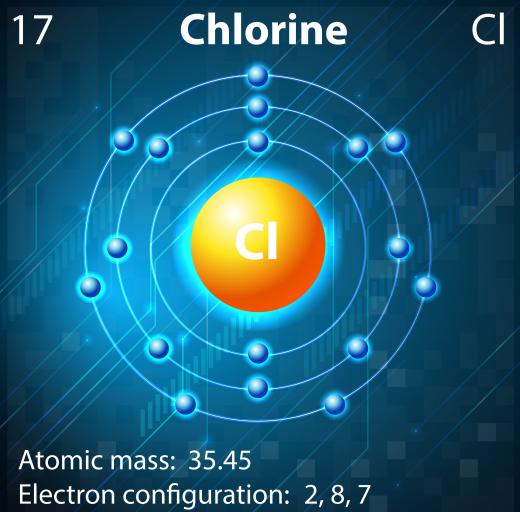What is the Aufbau Principle?
The Aufbau principle is a method of explaining the arrangements of electrons within atoms of different chemical elements. Atomic theory can be complex and difficult, but this principle provides a simple set of rules that can explain the electron configurations of the vast majority of elements. The term comes from a German word meaning “building out,” and refers to the way in which electrons are added to atoms going from lighter to heavier elements. The principle is not perfect, and there are a few exceptions, but it is a very useful tool for learning about atomic structure.
Shells, Subshells and Orbitals

To understand the Aufbau principle, it is necessary to look first at the structure of the atom. The electrons can be said to orbit the positively charged nucleus; however, there are certain rules that dictate how they can be arranged. In the generally accepted model, they occupy shells, which can be thought of as concentric, around the nucleus. Within these are subshells, within which are orbitals. An orbital describes the space inhabited by an electron.

Shells are numbered 1, 2, 3, etc., in order of increasing distance from the nucleus — and increasing energy levels — with the numbers also indicating how many subshells they can have. The subshells are labeled s, p, d and f, in general order of the energy possessed by electrons in the orbitals they contain. Each has a maximum number of orbitals that it can hold: s has only one, p has three, d has five and f has seven, and each orbital can contain a maximum of two electrons. All orbitals within a subshell have the same energy level.
This is summarized in the table below:
| Shells, Subshells and Orbitals | |||
|---|---|---|---|
| Shell | Subshell | Orbitals | Maximum Electrons |
| 1 | s | 1 | 2 |
| 2 | s | 1 | 2 |
| -- | p | 3 | 6 |
| 3 | s | 1 | 2 |
| -- | p | 3 | 6 |
| -- | d | 5 | 10 |
| 4 | s | 1 | 2 |
| -- | p | 3 | 6 |
| -- | d | 5 | 10 |
| -- | f | 7 | 14 |
This shows, for example, that shell 3 has an s, a p and a d subshell. When completely filled, it would have a total of 2 + 6 + 10 = 18 electrons. The electron configuration for an element can be written, for example, as:
which is element number five,
. This shows the shell number followed by the subshell letter, with the number of electrons it contains superscripted.
Constructing the Elements
It is possible to imagine building progressively heavier elements by adding electrons, starting with the lightest element, hydrogen (1s1). As electrons are added, they fill up orbitals within subshells within shells. It is a general rule that any system will adopt the configuration that has the lowest energy. While this is a very simple rule, determining the lowest energy arrangement, and explaining configurations, can involve a lot of complications, due to interactions between particles. Electrons will, naturally, tend to fill the lower energy orbitals before the higher energy ones, and the Aufbau principle seeks to explain how this happens.
The Rules
The Aufbau principle has just three rules:
- Electrons will fill orbitals in increasing order of energy — that is, they will fill the lowest energy orbitals first. Since all the orbitals in a given subshell have the same energy level, they must all be filled before the next subshell starts to fill.
- Each orbital can contain a maximum of two electrons, and these must have opposite spins.
- Where there are two or more orbitals available with the same energy level, none of them will be filled until they all have an electron. In other words, electrons will try to distribute themselves evenly across the available orbitals of the same energy wherever possible.
In the case of the simplest element, hydrogen, its one electron sits in an orbital in the s subshell. The next element, helium, has a second electron that goes into the same orbital: 1s2. The orbital, the s subshell and shell 1 are all now full. Lithium, with three electrons, has the same configuration as helium, but with an extra electron in the s subshell of shell 2, as that is the lowest energy orbital available: 1s22s1.
Skipping a couple of elements, carbon, with six electrons, has a 1s22s22p2 configuration: both the s subshells are filled, so the two remaining electrons go into the p subshell. They will go into different orbitals, according to the third rule of the Aufbau principle.
Exceptions
As elements get heavier, their arrangements of orbitals become more complex, and, sometimes, the interactions between electrons can produce exceptions to the Aufbau principle. The rules hold true until element number 24, chromium. This is one of a handful of elements that do not quite conform. It leaves its 4s subshell unfilled, while there are five electrons in the next subshell, because, in this unusual instance, it is a slightly lower energy configuration than that predicted by the rules. Other exceptions are copper and silver.
Uses
Despite the exceptions, the Aufbau principle is useful in chemistry courses where students discover the fundamental rules about the atomic structure and properties of elements. A chart or diagram may be used to show how the principle works for various example elements. This will usually show the shells, subshells and orbitals in a way that clearly illustrates how they are filled.
AS FEATURED ON:
AS FEATURED ON:












Discussion Comments
@hangugeo112: That is an oft misunderstood quote by Einstein. He was not referring to god as most people think of it. In other words, a personal god. He was referring to the structure and nature of the universe. No matter what he was referring to, using a quote from him to prop up your argument and then saying it would be silly to go against him is a fallacy (argument from authority). Scientists should always question and attempt to disprove others. It is how science works.
@ShadowGenius
So do you believe that "God plays dice?" Einstein denied this, and I think it would be silly to go against Albert Einstein.
@ShadowGenius
If, as you say, much of science is uncertain, then what is the basis for our belief in a solid and consistent world. As Einstein said, I do not believe that "God plays dice." There is consistency in the Universe which can be made very apparent to us- as shown in the Aufbau principal.
It is interesting to note that much of science is theoretical and can be proven by a minimalist approach: the system which accurately explains what happens in the physical world in the simplest form is taken to be correct. This leaves a lot of uncertainty, however, and requires a lot of faith in the scientific community. The greatest scientists relied heavily on intuiting new concepts which had to be subsequently disproven.
The aufbau principle is a nice example of the idea that nothing in science is completely proven. Even though it helps define the movement of electrons in many different situations, it is not applicable to absolutely every situation; until a theory seems possible that thoroughly disproves it, however, it will and should remain a basic concept of chemistry and physics.
Post your comments